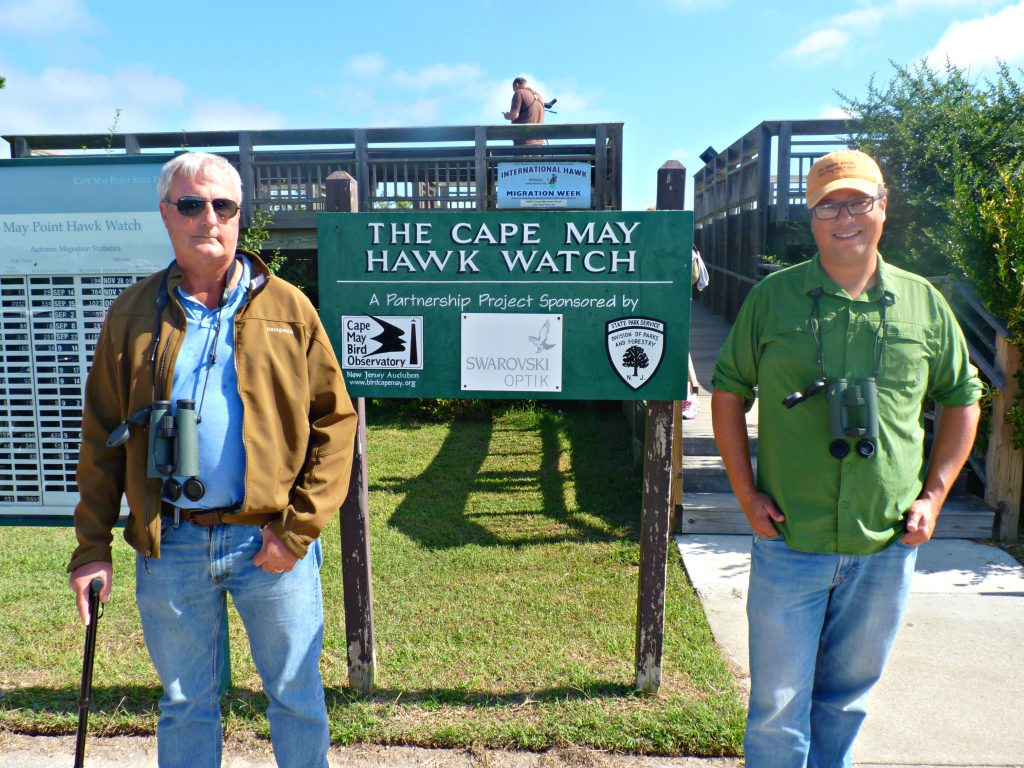By Gia Gallone
When you pull into the parking lot of Cape May Point State Park, you can’t help but immediately notice the many people standing on a large multilayered platform to your left with binoculars and cameras in hand. What could they possibly be looking at? What’s so fascinating up there? Well, birds, of course.
When Cape May Bird Observatory (CMBO) was founded 40 years ago in 1976 by New Jersey Audubon, Peter Dunne was a young 24-year-old with a passion for birding. A new employee at CMBO, Dunne served as the first hawk counter with the task of, well, counting hawks. His first day on the job, he identified Bunker Pond in Cape May Point State Park, surrounded by natural bushes, trees and grasses, as the best place to get his job done. He climbed on top of a four-foot sawed off telephone pole and started searching, but he quickly realized that this simply would not do. So he decided to build a small table to act as his hawkwatching platform, which became known as the Cape May Hawkwatch. This platform saw around 20 visitors that season.
The following year in 1977, Dunne became Director of CMBO. Shortly after, a more sufficient, 50-foot platform was built for hawkwatching, which eventually turned into a 100-foot platform, thus beginning the evolution of CMBO and the Hawkwatch. As birders began to flock to Cape May to witness the incredible vantage point Cape May Point State Park and the Hawkwatch had to offer, a new platform became necessary. The park demolished the old one and built the multilayered structure that stands there today, turning the birding industry in Cape May into a multimillion-dollar industry.
“In 1976, this was a multi-dollar industry,” joked Dunne, who now serves as CMBO’s Birding Ambassador. “The Hawkwatch saw dozens of visitors a year, and now it sees thousands.”
CMBO seeks to connect people to nature through research, environmental education, bird conservation and recreational birding activities. It has been successful in doing so by hosting people from around the globe, and educating them with its 800 year round programs ranging from daily walks to multi-day workshops for all skill levels. “There are 49 million birders in the United States,” Dunne stated, “and they all aspire to be here one day.”
“This is the hub for birders around the world,” added David La Puma, current CMBO Director of two years. He shared that in 2013, the Hawkwatch saw 20,000 visitors in September and October alone, and 100,000 throughout the year.
The success of CMBO has had an enormous impact on our local tourism economy, extending the shoulder season tremendously and bringing business to our neighboring shore towns all year round.
“Location, location, location,” responded Dunne when asked what the key to CMBO’s success is. “And of course the support of many likeminded individuals,” he added.
What makes Cape May such a prime ornithological location? As birds migrate south of Cape May for the winter, many species fly close to the coast to avoid traveling over vast bodies of water, where they are vulnerable to predators. Due to New Jersey’s peninsular configuration, these migrating birds are naturally funneled to the tip of the state – Cape May. So, if you’re interested in migration, the premium natural areas and open spaces you’ll find at Cape May Point State Park are the best places to witness and study flights. Believe it or not, the park is identified as the finest vantage point in North America. According to La Puma, “Nature happens here.”
“This spot attracts many talented people, from ornithologists to nature artists and photographers. If you’re into stocks, you want to be on Wall Street. If you’re into birds, this is your mecca,” said Dunne.
At the Hawkwatch, birders often spot young birds that hatched within the year, a sign of reproduction and survival, and an indication of a bright future for CMBO. Ornithology continues to grow in Cape May County, with the recent addition of the Avalon’s Seawatch. Avalon’s sea watching has been occurring since 1993, and the Borough of Avalon decided last year to build an official Seawatch blind on the beach between 8th and 9th streets. It is the perfect location to see migrating seabirds due to the fact that this spot extends farther out into the ocean, allowing southbound seabirds that are following the coastline to pass very close to the beachfront. Since the blind has been built, thousands more have come out to watch seabirds. “I envision that being the next Hawkwatch platform,” La Puma said with a smile.
CMBO and the Hawkwatch are celebrating their 40th anniversaries during the 2016 Cape May Fall Festival Oct. 20-24, the 70th consecutive fall weekend event held by New Jersey Audubon. “In addition to special workshops, we’ll be bringing back former hawk counters from the past four decades,” La Puma said.
With 40 years under their belts and counting, CMBO and the Hawkwatch will continue to enchant and captivate both avid birders and amateur visitors for years to come.







